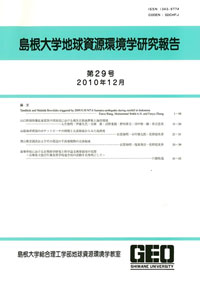島根大学総合理工学部地球資源環境学教室
ISSN:1343-9774

number of downloads : ?
Use this link to cite this item : https://ir.lib.shimane-u.ac.jp/38869
Geoscience reports of Shimane University 35
2016-12 発行
九州球磨川のSS(suspended solid)と付着藻類の地球化学的検討
Geochemical evaluation of SS (suspended solid) and periphyton samples of Kuma River, Kyushu
Hayashi, Yuko
File
Description
Biological concentration of elements in fresh water diatom of plankton and periphyton was examined from geochemical analysis using XRF (X-ray fluorescence analysis). This research was carried out in fluvial system of the Kuma River, Kyushu, Japan. Geochemical composition of SS (suspended solid) and periphyton (mainly of diatoms) are useful for evaluation of water environment. Diatom may show quick response to changes of water environment. To understand seasonal variation of water environments, series of samples were collected in February, April, June and October, 2015. Due to the passage of typhoon, sample collection in August was neglected.
To evaluate element concentrations of SS and periphyton, analytical results were normalized by average composition of fluvial sediments collected in 2015. The elements of biological accumulations are Zn, Cu, TS (total sulfur), F and P, which are demonstrated by SS / sediments diagram. SS, however, may contain significant amount of inorganic finer particles shown by positive good correlation between SS and Fe_2O_3 (r = 0.87). Water quality displayed by SS shows seasonal change, namely that of February sample indicated higher element concentrations in Zn, TS and P_2O_5 than those of other samples. This is related to enrichment of nutrient supply by snowmelt water. The periphyton / sediment diagrams show enrichment in Zn, Cu, Ni, TS, Br, Mn, P, suggesting different pattern of concentrations of elements comparing to those of SS. TiO_2 contents of periphyton samples show variation from 0.21 to 0.84 wt%, some of which exceed concentration of sediments (0.72 wt% in average). This indicated existence of finer minerals on periphytons. Characteristic geochemical feature of SS and periphyton can be observed in absence of iodine and Sr depletion. This contrasts to iodine concentration in higher plants and is suggestive that diatom may not absorb these elements.
To evaluate element concentrations of SS and periphyton, analytical results were normalized by average composition of fluvial sediments collected in 2015. The elements of biological accumulations are Zn, Cu, TS (total sulfur), F and P, which are demonstrated by SS / sediments diagram. SS, however, may contain significant amount of inorganic finer particles shown by positive good correlation between SS and Fe_2O_3 (r = 0.87). Water quality displayed by SS shows seasonal change, namely that of February sample indicated higher element concentrations in Zn, TS and P_2O_5 than those of other samples. This is related to enrichment of nutrient supply by snowmelt water. The periphyton / sediment diagrams show enrichment in Zn, Cu, Ni, TS, Br, Mn, P, suggesting different pattern of concentrations of elements comparing to those of SS. TiO_2 contents of periphyton samples show variation from 0.21 to 0.84 wt%, some of which exceed concentration of sediments (0.72 wt% in average). This indicated existence of finer minerals on periphytons. Characteristic geochemical feature of SS and periphyton can be observed in absence of iodine and Sr depletion. This contrasts to iodine concentration in higher plants and is suggestive that diatom may not absorb these elements.
Other Article
PP. 7 - 16
